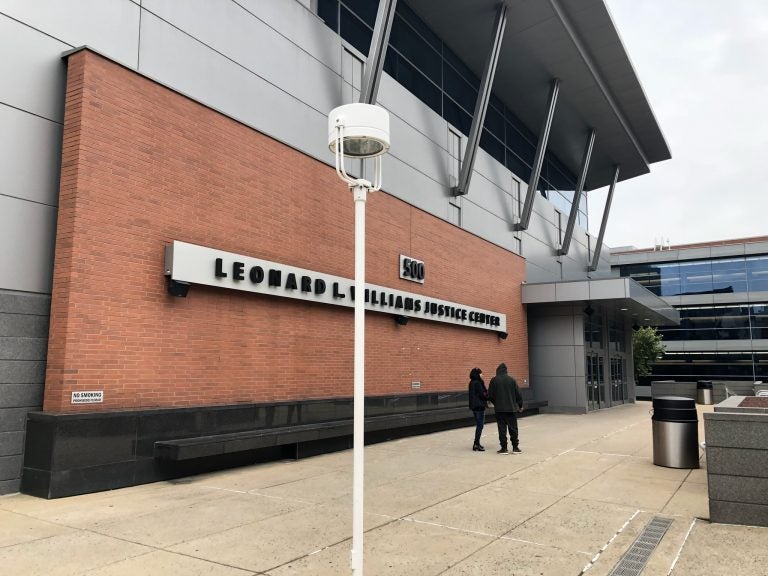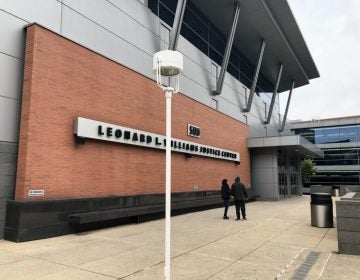Jury gets the case in Vaughn prison uprising trial
Listen 1:34
A 12-member jury are deliberating charges against inmates allegedly involved in a prison riot (Cris Barrish/WHYY)
Prosecutors and defendants argued over the legitimacy of evidence and inmate testimonies during closing arguments in a trial for three prisoners allegedly involved in a February 2017 riot that left a correctional officer dead.
Defendants Jarreau Ayers, Deric Forney and Dwayne Staats are charged with murder, assault, kidnapping, riot, and conspiracy for the 18-hour uprising at the James T. Vaughn Correctional Center near Smyrna, which killed correctional officer Lt. Steven Floyd.
The defendants argue while they wanted to protest poor conditions at the prison, they never intended to kill Floyd.
“The truth is revealing harsh realities, the truth can set you free literally and figuratively, and sometimes the truth hurts the ones you love. The truth is frequently summoned to contest dishonest deceit, untrustworthiness, contradictions and fabrications. These are all byproducts of the state’s presentation, which is hinged on an insufficient investigation,” said defendant Staats, who is representing himself in the trial.
However, prosecutors paint a grimmer picture of what happened in the prison.
“It was not a protest gone wrong. It was planned, it was organized, and the attacks were done simultaneously on the correctional officers inside. They were restrained and secured,” said prosecutor John Downs.
“According to Mr. Ayers, the inmates were liberated, and they began to have fun, and they’re just walking around and cooking and talking and eating. That is not what happened. This wasn’t fun, and this wasn’t liberation — it was terror, it was injuries, it was restraint, it was death.”
A year ago, 18 inmates were charged in connection with the standoff, and 16 of them were charged with first-degree murder. Over the next several months, multiple 12-member juries will be chosen for the trials of about four defendants at a time. Each trial is expected to last about four weeks.
Ayers and Staats, both representing themselves at trial, already are serving life sentences for murder, while Forney is serving 11 years for various firearm and drug charges.
On Feb. 1, 2017, there were 134 people in the C Building, a medium- to maximum-security section of the prison — including 126 inmates. The remaining individuals included a few correctional officers and a counselor, as well as workers repairing a boiler in the basement.
Prosecutors say when Floyd opened the door to the C Building to allow inmates back inside after their recreational period, a group stormed the building, and attacked the officers with mop wringers and homemade knives or “shanks.”
Floyd was handcuffed and placed in a mop closet, while two other officers were placed in a supply closet, prosecutors say. The female counselor was approached by an inmate wielding a knife who put a bag over her head and bound her feet while holding her captive in her office, prosecutors say.
This week, defendant Staats admitted he held the counselor captive, but said he enlisted another inmate who knew her well to protect her from inmates with ill intentions.
Prosecutors say when emergency responders entered the building, Floyd told an officer to leave, warning, “It’s a trap.”
The correctional officers trapped inside the supply closet testified during trial they were beaten, had burning objects thrown on them, and could hear Floyd moaning in pain. Floyd died from blunt force and stabbing trauma, and was found faced down in his office, covered with debris.
Downs said while the counselor was not physically harmed during the incident, she still suffered a terrifying ordeal. And while the other two correctional officers survived, they testified during trial they suffered fractures and concussion, as well as post-traumatic stress disorder, anxiety and depression.
Staats negotiated with police over radio, roaming the prison with a walkie talkie and a shank, say prosecutors and prisoners they called to testify.
Staats also wrote a letter in which he takes responsibility for the riot. He writes he was proud of his plan. “Those saying the uprising had to happen knew shit was going to get worse before it gets better. Honestly it feels surreal knowing everything that transpired started with one thought, and that’s generally with anything. One thought that keeps getting nurtured it manifests in reality.”
This week, Staats testified the whole incident was his idea, telling the jury he recruited inmates with life sentences who had “nothing to lose” to take correctional officers hostage. He said six inmates were involved but refused to name them.
Staats also testified he was able to orchestrate the incident because he flies under the radar. He said the event had to occur in order to address the poor conditions in the prison, and said an independent report requiring reforms ordered by Gov. John Carney matches the stipulations he asked for during the riot.
Staats said he never intended the takeover to be deadly, however.
Prosecutor Brian Robertson tried to refute that claim.
“Mr. Staats’ testimony was that he was part of the plan, he was the genesis of the plan, and it was his vision to do something beyond a peaceful protest. How is this going be different? This was going to be takeover of building,” Robertson said. “You can’t have a takeover of C Building without violence. It was the violence he contemplated.”
Prosecutors say the most damning evidence against Ayers is a recorded phone conversation with his sister in which he asks for commissary money to stock up on peanut butter and crackers and water, because something is “going to go down” after the Super Bowl, saying “Electric cut off, water cut off, everything. Y’all gonna know about it, ya’ll gonna see it.”
Ayers argues he didn’t know about the takeover until the night prior, because he had only had discussions about a peaceful protest. He said he didn’t get involved in the takedown until he learned some inmates had medical needs and he attempted to free them.
“Me knowing something was going to happen is different from me planning something,” Ayers said.
Prosecutors argue the tape proves he knew it would be more serious than a peaceful protest.
Prosecutors and other inmates say Forney assaulted one of the officers during the beginning of the riot to aid in the hostage taking. But his attorney Ben Gifford said there’s no evidence to show he played an active role in the uprising—arguing a couple inmates testifying they saw him assaulting an officer is not sufficient.
“He’s not just not guilty, Mr. Forney is innocent, he told you so under oath,” he said.
Robinson argued in his rebuttal that while there is more evidence against the other two defendants, Forney’s role was still integral to the uprising.
“Mr. Forney by no accounts was part of the big plan in the way Dwayne Staats memorialized in a written document, the plan Mr. Ayers knew enough about and knew it was going to be different to call up his sister,” he said. “You can’t take over the building with just a few people, you need foot soldiers, and Forney was a foot soldier. It doesn’t mean he signed on to everything, it doesn’t mean he’s even friends with these guys. But his actions on that day mattered.”
Among the counts, the defendants face charges of intentional murder, reckless murder and the death of a law enforcement officer.
Downs argued Floyd’s death was intentional because medical experts say if he had been released earlier he wouldn’t have bled out and died. He said the defendants are guilty of reckless murder because the risk of death was present when knives, mop ringers and fire extinguishers being used as weapons.
He argues that while not every person murdered Floyd, and there’s no evidence about who inflicted the final blow, they were all accomplices in an event that caused his death.
Gifford argued the defendants cannot be found guilty of intentional murder because there was no “death blow.” He also argues no one was “stabbing to kill” or “hitting to kill.”
The defense also argued there are multiple flaws and holes in the investigation, and point out there’s no DNA evidence that connects them to the crime. Prosecutors argue DNA didn’t come into play in this case because since the inmates lived in the building, finger prints would be unreliable.
“Picture this, a man kills his wife and is suspected to have killed her with a gun, and a gun is lying on the floor. If Mr. Downs was prosecuting that case, do you think he would get up and say, ‘look we have a gun, but we can’t give much credit to his DNA because he lives there?’” Gifford told the jurors.
“Floyd didn’t deserve what happened to him, but he didn’t deserve this investigation.”
The defense also argued the state’s inmate witnesses are unreliable because their testimonies do not match, and that testimony given in the court room is different than those they gave to law enforcement and the attorney general’s office after the incident took place.
“They’re taking real events that happened and are plucking themselves in there” Gifford said of the witnesses.
Robinson argued that’s because they all saw the event from different vantage points, because individuals were constantly moving. He also said it’s normal that witnesses’ courtroom testimonies are different from earlier statements.
“Did they remember every last detail what they told investigators 18 months ago? No. What would it tell you if they were word for word solid on every detail? Is that consistent of what people know about memory, about passage of time, about tragic events?” Robinson said.
The defense has also focused on the state’s “star witness” Royal “Diamond” Downs, an inmate from Maryland serving a life sentence for first-degree murder. They say he got a cushy plea deal for testifying against his fellow inmates, despite being the “head honcho” inmate in the prison. They also say inmates are testifying in order to get moved to prisons in other states with better conditions.
Prosecutors refute that claim, and states Downs is the most reliable witness—he even testified he saw one of the inmates put a knife to Floyd’s throat, and the medical examiner stated there was an injury to the throat.
In December, the state paid $7.5 million to settle a lawsuit filed by six workers in the Department of Correction and five others — including Floyd’s widow and children. The lawsuit was filed against the DOC and former governors Jack Markell and Ruth Ann Minner, as well as other prison and budget administrators. They were accused of failing to properly fund and operate the DOC and its facilities.
An independent review of the prison found a dysfunctional, adversarial culture between prison leaders and the rank-and-file, and correctional officers and inmates, both of which, the report states, contributed to the deadly siege.
Carney has set aside dollars in his budget to address some of the issues outlined in the report.
WHYY is your source for fact-based, in-depth journalism and information. As a nonprofit organization, we rely on financial support from readers like you. Please give today.




